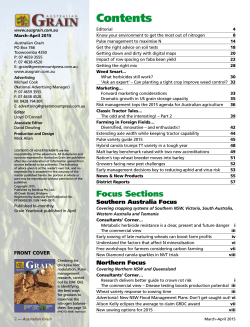
High temperature tolerance in grain legumes
RESEARCH High temperature tolerance in grain legumes by Pooran M. GAUR1*, Srinivasan SAMINENI1, Laxman KRISHNAMURTHY1, Shiv KUMAR2, Michel E. GHANEM2, Stephen BEEBE3, Idupulapati RAO3, Sushil K. CHATURVEDI4, Partha S. BASU4, Harsh NAYYAR5,Veera JAYALAKSHMI6, Anita BABBAR7and Rajeev K. VARSHNEY1 Abstract: High temperature stress (or heat stress) during reproductive stages is becoming a serious constraint to productivity of grain legumes as their cultivation is expanding to warmer environments and temperature variability is increasing due to climate change. Large genetic variations exist in grain legumes for heat tolerance which can be exploited for development of locally adapted heat tolerant cultivars. Heat tolerant cultivars will be more resilient to the impacts of climate change, allow flexibility in sowing dates and enhance opportunities for expanding area of grain legumes to new niches and cropping systems. Key words: chickpea, common bean, faba bean, heat stress, lentil Heat stress is increasingly becoming a serious constraint to grain legumes production in certain regions due to a large shift in area of grain legumes from cooler, long season environments to warm, shortseason environments, e.g. shift in chickpea (Cicer arietinum L.) area from northern to southern India; increase in area under late sown conditions; and reduction in winter period and increase in temperatures due to _________________________________________________________________________________________________________ 1International Crops Research Institute for the Semi-Arid Tropics (ICRISAT), Hyderabad, India (p.gaur@cigar.org) 2International Center for Agricultural Research in the Dry Areas (ICARDA), Rabat, Morocco 3International Center for Tropical Agriculture (CIAT), Cali, Colombia 4Indian Institute of Pulses Research (IIPR), Kanpur, India 5Panjab University, Chandigarh, India 6Regional Agricultural Research Station, Nandyal, India 7Jawaharlal Nehru Agricultural University, Jabalpur, India climate change. Many countries could experience unprecedented heat stress because of global climate change (5). Heat sensitivity in grain legumes can reduce yields, product quality, and lead to restricted geographic adaptation. A high temperature of 35 °C was found critical in differentiating heat tolerant and heat sensitive genotypes in chickpea, lentil (Lens culinaris Medik.) and faba bean (Vicia faba L.), while heat sensitive lines of common bean (Phaseolus spp.) lose yield when night temperature is higher than 20 °C. Effects of heat stress on grain legumes before flowering include reduction in germination percentage and increase in occurrence of abnormal seedlings; early flowering; degeneration of nodules affecting the nitrogen fixation efficiency; reduction in membrane stability, photosynthetic / mitochondrial activity and plant biomass. Heat stress during the reproductive phase affects pollen viability, fertilization, pod set and seed development leading to abscission of flowers and pods and substantial losses in grain yield. Heat stress often leads to soil moisture deficit during reproductive growth stages of grain legumes thus predisposes them to necrotrophic pathogens such as Rhizoctonia bataticola causing dry root rot disease. Selection for heat tolerance can be effectively made by planting the crop at high-temperature hot spot or under latesown conditions and selecting the plants/progenies based on number of filled pods per plant and grain yield. Pollen-based screening methods can also be used for evaluating genotypes for tolerance to heat stress. Genetic variation for heat tolerance has been identified in almost all grain legumes. Diverse sources of heat tolerance should be exploited to develop heat tolerant cultivars. The precision and efficiency of breeding programs can be enhanced by integrating novel approaches, such as marker-assisted selection, gametophytic selection and precise phenotyping. Legume Perspectives 23 One of the Product Lines of the CGIAR Research Program on Grain Legumes (http://grainlegumes.cgiar.org/) is on Heat tolerant chickpea, common bean, faba bean and lentil. It will help in establishing common sites and protocols for heat tolerance screening and comparing the levels of heat tolerance available in these legumes. It will also provide an opportunity for comparative studies on physiological mechanisms and genetics of heat tolerance in these legumes. Chickpea. A field screening technique has been standardized for screening of genotypes for heat tolerance in chickpea (4). High temperatures reduced pod set in chickpea by reducing pollen viability and pollen production per flower (2). Stigma receptivity can also be affected at very high temperatures (≥ 40/30 0C) leading to failure of fertilization (8). Change in level of abscisic acid was found to be associated with heat tolerance response (7), while impaired sucrose metabolism in leaves and anthers was associated with heat stress induced reproductive failure (6). Grain yield under high temperatures was found to be negatively correlated with days to flowering and days to maturity and positively correlated with plant biomass, number of filled pods per plant and number of seeds per plant (3). ICRISAT and ICARDA with national research partners in Asia and Africa have identified several heat tolerant genotypes (cultivars / elite lines / germplasm accessions) in desi (ICCV 92944, ICCV 93952, ICCV 96970, ICCV 94954, ICCV 07102, ICCV 07110, ICCV 07109, ICCV 07118, ICCV 07117, ICCV 07105. ICCV 07108) and kabuli (ICCV 95332, ICCV 92318, FLIP87-59C, Salawa, Burguieg, S051708, S00998, S03308, S03525, S051702, S051412, S03302, S02266, S051685, S051703) chickpea (Fig. 1). A heat-tolerant chickpea line ICCV 92944 has been released in three countries (JG 14 in India, Yezin 6 in Myanmar and Chaniadesi 2 in Kenya) and area under its cultivation is expanding rapidly. In Myanmar, it covered over 40,000 ha during 2012-2013 crop season (9). Issue 7 • April 2015 RESEARCH Figure 1. A heat-sensitive (left) and a heattolerant (right) chickpea genotype Common bean. Heat stress is a major constraint to common bean production and breeding for heat tolerance could benefit 7.2 million ha (some of which could benefit by drought tolerance), of common bean and could increase highly suitable areas by some 54% (1). Under heat stress, the grain yield in common bean showed significant positive correlation with pod harvest index, pod partitioning index, harvest index, canopy biomass, 100 seed weight, pod number per area, and seed number per area. The heat tolerant genotypes are able to form pods and seeds and to fill seeds under heat stress Genetic variability available for heat tolerance in tepary bean (Phaseolus acutifolius A. Gray) has been exploited for improving heat tolerance in common bean at CIAT. Interspecific lines derived from crosses of tepary bean with common bean were found to have higher yield over common bean checks under heat stress conditions. Faba bean. Being a crop of relatively high moisture areas, faba bean is very sensitive to water and heat stresses particularly in the Mediterranean region. The irrigated faba bean crop in Sudan and Egypt is severely affected by heat stress mainly during flowering and podding stages. Therefore, efforts are being made to develop faba bean genotypes that are more adapted to heat stress conditions in these areas. Preliminary evaluation of different faba bean breeding lines under heat stress was conducted at ICARDA through late and summer planting in Tel Hadya (Syria) and Terbol (Lebanon), respectively. During flowering and podding period the temperature reached 38 0C for late planting and 41 0C in summer planting in Terbol. The preliminary results showed that only 0.3% of the tested germplasm can be considered as tolerant to heat. Two faba bean varieties (Shendi and Marawi) with tolerance to heat were released in Sudan. Lentil. Delayed sowing in field is commonly used for evaluating heat tolerance during reproductive stage in lentil. Number of filled pods per plant under heat stress showed significant positive correlation with pollen viability and has been used as a key trait for assessment of heat tolerance. Focused Identification of Germplasm Strategy (FIGS) selected germplasm for heat tolerance screening. Evaluation of germplasm under delayed planting with regular irrigation has led to identification of several heat tolerant genotypes in Morocco (ILL2181, ILL82, ILL5151, ILL5416, ILL4857, ILL956 and ILL598) and India (FLIP2009-55L, ILL2507 and ILL4248). Improving heat tolerance in these legumes would increase yield stability, protect against global warming, and maintain and extend the geographical range of cultivation, particularly in lower elevations in many countries. Heat Figure 2. A heat-sensitive (left) and a heat-tolerant line (right) of common bean Legume Legume Perspectives Perspectives 9 24 tolerant cultivars would enhance opportunities for expanding area of grain legumes to new niches and cropping systems, such as rice-fallows in south Asia for chickpea and lentil and maize-based systems in east and southern Africa for common bean and faba bean. Acknowledgements Partial funding support from CGIAR Research Program on Grain Legumes. References (1) Beebe S, Ramirez J, Jarvis A, Rao IM, Mosquera G, Bueno GM and Blair M (2011) Genetic improvement of common beans and the challenges of climate change. In: Yadav SS, Redden RJ, Hatfield JL, Lotze-Campen H, Hall AE (eds) Crop Adaptation to Climate Change. Blackwell Publishing, Richmond, 356-369 (2) Devasirvatham V, Gaur PM, Mallikarjuna N, Raju TN, Trethowan RM, Tan DKY (2012) Effect of high temperature on the reproductive development of chickpea genotypes under controlled environments. Funct Plant Biol 39:1009-1018 (3) Devasirvatham V, Gaur PM, Raju TN, Trethowan RM and Tan DKY (2015) Field response of chickpea (Cicer arietinum L.) to high temperature. Field Crop Res 172:59-71 (4) Gaur PM, Jukanti AK, Samineni S, Chaturvedi SK, Basu PS, Babbar A, Jayalakshmi V, Nayyar H, Devasirvatham V, Mallikarjuna N, Krishnamurthy L, Gowda CLL (2014) Climate change and heat stress tolerance in chickpea. In: Tuteja N, Gill SS (eds) Climate Change and Plant Abiotic Stress Tolerance 2. Wiley - VCH Verlag GmbH & Co. KGaA, Weinheim, 839-855 (5) Kadam NN, Xiao G, Melgar RJ, Bahuguna RN, Quinones C, Tamilselvan A, Prasad PVV, Jagadish KSV (2014) Agronomic and physiological responses to high temperature, drought, and elevated CO2 interactions in cereals. Adv Agron 127:111-156 (6) Kaushal N, Awasthi R, Gupta K, Gaur P, Siddique K, Nayyar H (2013) Heat-stress-induced reproductive failures in chickpea (Cicer arietinum) are associated with impaired sucrose metabolism in leaves and anthers. Funct Plant Biol 40:13341349 (7) Kumar S, Kaushal N, Nayyar H, Gaur P (2012) Abscisic acid induces heat tolerance in chickpea (Cicer arietinum L.) seedlings by facilitated accumulation of osmoprotectants. Acta Physiol Plant 34:1651-1658 (8) Kumar S, Thakur P, Kaushal N, Malik JA, Gaur P, Nayyar H (2012) Effect of varying high temperatures during reproductive growth on reproductive function, oxidative stress and seed yield in chickpea genotypes differing in heat sensitivity. Arch Agron Soil Sci 59:823-843 (9) Win MM, Shwe T, Gaur PM. 2014. An overview of chickpea breeding programs in Myanmar. Legum Perspect 3:62-64 Issue Issue 71 •• April January 2015 2013
© Copyright 2025









